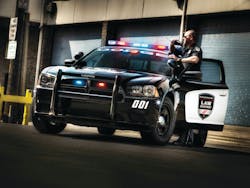Voluntary safety recall
Someone had to dig a hole, take a rock and live underneath it for a few months to avoid hearing about the massive Toyota recall a few years back. Make that recalls.
Each was on a few different issues, with a substantial amount of media’s attention to a stuck accelerator pedal. All this probably even inspired a few people to even try it as an excuse to talk out of a speeding ticket.
The manufacturer took action, made aware the appropriate parties and–eventually–problems were addressed.
In February this year, among the many they release, the National Highway Traffic Safety Administration announced another recall; this time for a police-only vehicle.
It effects years 2011 and 2012 Chrysler Dodge Charger police vehicles, produced between July 5, 2010 and December 20, 2011. It technically involves two parts, one a bulb harness connector and a power distribution module.
These apparently overheat.
Again, this is a voluntary safety recall affecting approximately all of an estimated 9,688 vehicles.
Specific details
The recall announces that the low beam headlamps of some vehicles could fail due to the overheating of a bulb harness connector. The harness connection resembles a few gathered insulated cables with specific connector heads on its ends.
Like dominoes knocking each other down, this heat can also cause a loss of ABS/ESC system’s function due to an overheated power distribution center.
The announcement puts it quite blunt, “this could lead to loss of visibility and/or braking ability, increasing the risk of a crash.”
For those unfamiliar with these terms, antilock braking systems (ABS) is an automatic system which pulses the brake in hopes to avoid locking—thus the name—the wheel. Electronic stability control (ESC) works to adjust the vehicles spinning wheels in a potentially slippery situation. It automatically applies the brake without driver input to lessen over steering and get the vehicle back to the direction where it was intended to go.
The recall release also mentions that beginning in March, Chrysler had begun notifying “owners and dealers to replace the headlamp jumper harnesses and relocate the ABS/ESC system fuse within the power distribution center.”
In their official statement, David Dillon, Head of Product Investigation and Campaigns explains what could be causing the malfunction. “The conditions tend to occur when police vehicles are exposed to severe police duty vehicle cycles for an extended period of time including, long durations of high speed, evasive driving when used as training vehicles for police forces and extended idling,” he says.
Dillon adds that “[they] will continue to monitor the retail fleet for any occurrence of this condition beyond police vehicles.”
The official statement also mentions that Chrysler Group is not aware of any accidents or injuries related to this condition.
Safety
Recalls are an effort to make vehicles that much more safe for our officers—just one more feature bringing them home each day. The stimga of the word "recall" however does come with some raised eyebrows. Somehow "recall" tends to lead to twisted metal, burnt tire tracks and dollars (and hours) spent in maintenence.
Days after the recall announcement, Chrysler also released some safety press of their own. This release mentions the NHTSA (the same organization affecting the recall) granted the 2012 Dodge Charger and 300 models a five-star safety rating. This is the highest rating available which represents, according to the official release, "a combination of frontal, side pole and barrier performance with static satability factor accounting for rollover rating."
While the recall is voluntary, in what feels like an attempt to encourage its customers to act, Chrysler has announced that any incurred cost (if any at all) to a department or agency will be refunded.
The life of a recall notice
- In late August (2011), the Quality Engineering Center (QEC) identified two returned Police vehicle headlamps with melted low beam connectors.
- An investigation determined via bench testing, that the bulb's operating temperature was in excess of the connector material specification resulting in material migration.
- On November 8, 2011, a material change to the terminal and connector was implemented at Brampton Assembly Plant.
- On December 8, 2011, a Michigan State Police training vehicle with a repeatable loss of ABS/ESC system power, during a maneuverability duty cycle was reported.
- On December 9, 2011 a PRJ was initiated and the yard was held at Brampton Assembly Plant (SAP).
- It was determined that thermal expansion and contraction of the plastic insert surrounding the fuse led to distortion of the bus bar terminal creating the intermittency.
- On December 20, 2011, a relocation of the ABS/ESC system fuse along the Bus bar was implemented.
- Subsequent field data analysis indicated an increasing trend in field inputs.
- Chrysler LLC is aware of 25 head lamp inputs and 34 ABS/ESC inputs on police vehicles to date.
Source: Defect Information Report For Chrysler Group LLC, National Highway Traffic Safety Association, SaferCar.gov
- NHTSA Campaign ID: 12V042000
- Chrysler’s Recall Number: M01
Contact info
- Chrysler: 800-853-1403, www.fleet.chrysler.com
- NHTSA 800-424-9153, www.safercar.gov

Jonathan Kozlowski
Jonathan Kozlowski was with Officer.com, Law Enforcement Technology, and Law Enforcement Product News from August 2006 to 2020.
As former Managing Editor for Officer Media Group, he brought a dedicated focus to the production of the print publications and management of the Officer.com online product and company directory. You can connect with Jonathan through LinkedIn.
Jonathan participated as a judge for the 2019 and 2020 FOLIO: Eddie & Ozzie Awards. In 2012, he received an APEX Award of Excellence in the Technology & Science Writing category for his article on unmanned aerial vehicles (UAVs) in police work, aptly titled "No Runway Needed".



